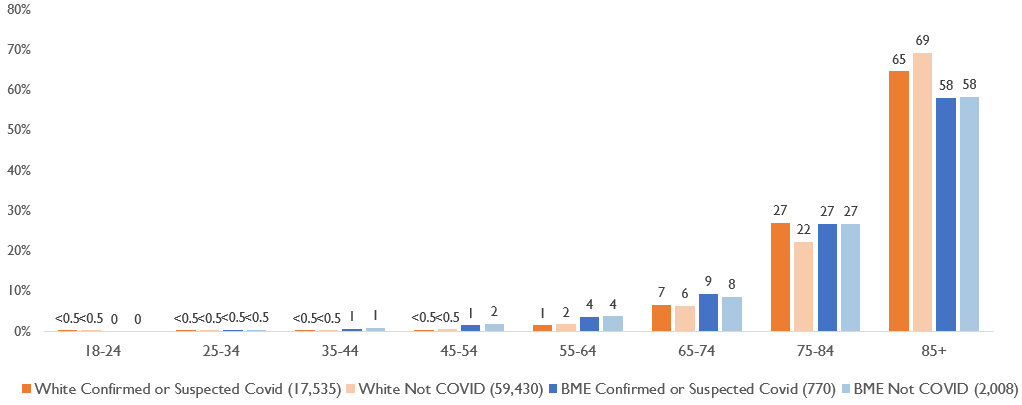In previous briefings, we have published data drawn from the notifications of deaths in adult social care, submitted to CQC from April 2020 onwards. We have specifically looked at the numbers of deaths of people with a learning disability or autistic people, compared with the numbers in the previous year, and analysed all deaths in adult social care by ethnicity and COVID-19 status.
We found that in care homes in particular, a higher proportion of Black and Asian people who had died had confirmed or suspected COVID-19 flagged on their notification form than was the case for White people. In our previous update, covering deaths notified from 10 April to 16 November 2020, we found that 31% of the deaths of Black people were flagged as ‘confirmed or suspected COVID-19’ compared with 23% of White people.
We have now carried out further analysis on this dataset in an effort to improve our understanding of these issues.
We first examined whether there were any differences in the propensity for deaths to be flagged for COVID-19 between people with a learning disability or autism and those without.
1. People with a learning disability were slightly more likely to have died with confirmed or suspected Covid-19 than others in care homes whose death was notified to us

*A person who had a learning disability and whose death was reported by a provider of services for people with learning disabilities or autism. Deaths reported with missing disability data have been excluded from this analysis.
While the vast majority of deaths in care homes were of people with no learning disability (84,600), we have identified almost 600 deaths of people with a learning disability or autism and 26% (152) of these were flagged for COVID-19 compared with 23% of those without a learning disability.
We then looked at the disaggregation of the data by learning disability status, ethnicity and COVID-19 status.
2. Our data showed no discernible differences based on sufficiently large numbers between the deaths of people from Black and minority ethnic groups, with and without a learning disability or autism, and White people with or without a learning disability or autism
This could be due to the very low numbers of deaths in some of the categories once the data was disaggregated: out of almost 79,000 deaths for which we held data on ethnicity and disability status, 28 were of BME people with a learning disability or autism, which represented 0.04% of deaths.
Finally, we examined the deaths in our dataset by ethnicity, COVID-19 status and age group.
3. People from Black and minority ethnic groups who died were slightly younger in age than White people who died, reflecting demographic trends in the wider population

Deaths with missing ethnicity or age data have been excluded from this analysis.
The chart shows that there is a slightly younger age profile for the deaths of all people from BME groups (regardless of COVID-19 status) than for White people, for whom a higher percentage of deaths were among those aged 85 and over. Among White people who died, the deaths flagged as confirmed or suspected COVID-19 appear to be slightly skewed towards those aged 75-84, compared with those aged 85 and over. This pattern is not surprising as it reflects population data which shows the proportion of the population identified as BME is much lower in the older age groups than across the population as a whole. Estimates based on the 2011 census suggest 98% of people over 85 in the UK are White, falling to 95% of those aged 65 to 85 and 84% of those under 65.
What does the analysis tell us about COVID-19 deaths in adult social care?
This further disaggregation of the data does not explain why people from BME groups or those with a learning disability or autism might be more likely to have died with COVID-19 flagged on their notification form than others, but the broad patterns do align with the findings of other organisations, for example Public Health England and the Learning Disabilities Mortality Review (LeDeR) programme.
Read more...
Download the report
You can download a version of this report if you want to print or share it with your team.
Related news
You can also read our news stories about the publication of these reports:
Previous issue
You can read the issue of the report that we published in December. This issue looked at designated settings and care home capacity as well as our provider collaboration reviews.